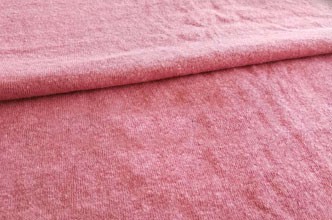Product Description
Home > Fabric > Knit Fabric > Hemp Knit Fabric > Single Jersey
SINGLE JERSEY WITH HEMP FABRIC
Single jersey fabric is a type of weft knitted fabric. The knitting machine used to manufacture single jersey fabric has just one row of needles, whereas with interlock there are two.
This creates just one layer of fabric and this is where single jersey fabric gets its name.
Suggested uses:
Single jersey fabric is often used for sports t-shirts and leggings. This is because the material is very breathable so sweat doesn’t stay locked between the garment and the skin. It’s also a popular option for regular t-shirts too.
Bear in mind that these are just examples. Fabrics don’t have to be used for a specific application. As long as a material fits your design, it’s suitable for the job.
Customization of the product is also available on the basis of:
• GSM (Gram / Sq. meter): 100 - 250 GSM
• Material/Composition: 100% Hemp or can be blended with other fibers as per the requirement.
• Fabric type: Knit
• Weave type: Knit : Single Jersey / Rib / Pique / Velour / Fleece / Interlock / French Terry
HEMP
Hemp has been in use since 770 AD. Since that time, it has been used to make everything from rope to clothing, to paper. A step away from cotton, the drape and hang of hemp has been compared to linen. Hemp fabric becomes softer with use and it also absorbs moisture quickly, keeping your body dry. Being one of the most durable fibers on earth, hemp isn't going anywhere for a long time.
How much Sustainable & ecological hemp is?
• Hemp is one such sustainable fabric that we can switch to, and that has the potential to make the situation better for us as well as for the environment.
• It takes a lot less water and energy in the production of this super fabric as compared to other fabrics.
• Adding to that, hemp is biodegradable and breaks down easily in the environment, going back to where it came from and creating less waste.
• This means that even if there comes a need to discard the hemp clothing that we own, we can be sure that it will not stay back in the pile of clutter for long.
How comfortable hemp is for clothing?
• Hemp is more water-absorbent than cotton, it will retain dye better than any other fabric, keeping your colors from fading better than Tide can.
• Hemp also has a porous personality that allows it to breathe, keeping you cool in the summer. And like bamboo and wool, hemp is warmer in cooler weather.
• Hemp also has a porous personality that allows it to breathe, keeping you cool in the summer. And like bamboo and wool, hemp is warmer in cooler weather.
• Hemp is the longest and strongest plant fiber. Because we are very concerned about our natural resource, water, it is heart-warming to know that hemp only uses 1/20th the amount of water to grow and process as regular cotton.
• Hemp is naturally less vulnerable to insects and crowds out other weeds so pesticides and fertilizers become obsolete when we deal with hemp.
• It does not even need a lot of care, it can be maintained with minimal efforts. Once your hemp clothing is worn off, which might take a really long time, the fabric can be reused and recycled with great ease.
FACTS ABOUT HEMP CLOTHING
• Hemp protects your skin by naturally filtering UV light.
• Hemp resists bacterial growth and breathes excellently, preventing odors.
• Hemp resists bacterial growth and breathes excellently, preventing odors.
• Hemp resists bacterial growth and breathes excellently, preventing odors.
• It saves Water! Hemp uses only 1/20th the amount of water as regular cotton to grow and process.
• Also, Hemp uses almost no water to grow and can usually be rain-fed.
• It saves Jobs! Hemp is harvested and processed by hand, keeping people employed.
• Unlike cotton which depletes the soil of nutrients, hemp can be grown consecutively for over twenty years without the soil being affected.
• Hemp is illegal to grow in the U.S., though not illegal to import.
• Hemp is deliciously soft on the skin, more and more with each wear.
Making a shift to sustainable clothing is the need of the hour. Sustainability is no longer an option, it will have to be the only alternative available. In such a situation, there is nothing better than shifting to an organic, naturally occurring fabric like hemp that will be both comfortable and stylish and will also serve the cause of sustainable clothing in the best possible manner.
So take one step at a time, do what's best for the environment as we as your own self. Now that all your confusions have been brushed off, making the switch will be a cakewalk.


